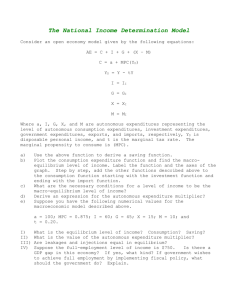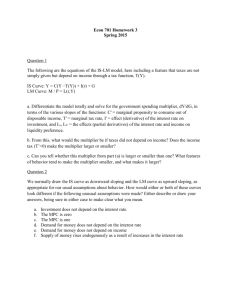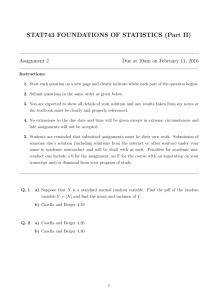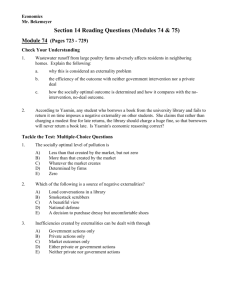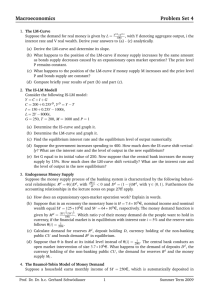Additional Problems_Some Solutions
advertisement
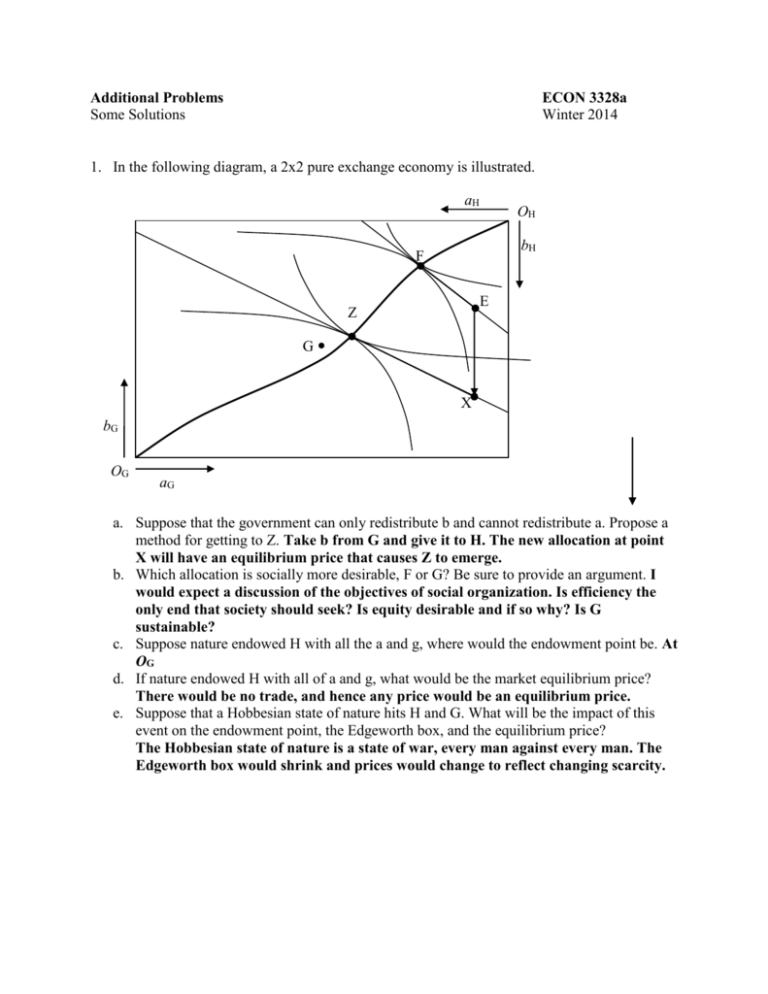
Additional Problems Some Solutions ECON 3328a Winter 2014 1. In the following diagram, a 2x2 pure exchange economy is illustrated. aH OH bH F E Z G X bG OG aG a. Suppose that the government can only redistribute b and cannot redistribute a. Propose a method for getting to Z. Take b from G and give it to H. The new allocation at point X will have an equilibrium price that causes Z to emerge. b. Which allocation is socially more desirable, F or G? Be sure to provide an argument. I would expect a discussion of the objectives of social organization. Is efficiency the only end that society should seek? Is equity desirable and if so why? Is G sustainable? c. Suppose nature endowed H with all the a and g, where would the endowment point be. At OG d. If nature endowed H with all of a and g, what would be the market equilibrium price? There would be no trade, and hence any price would be an equilibrium price. e. Suppose that a Hobbesian state of nature hits H and G. What will be the impact of this event on the endowment point, the Edgeworth box, and the equilibrium price? The Hobbesian state of nature is a state of war, every man against every man. The Edgeworth box would shrink and prices would change to reflect changing scarcity. 2. Suppose that there is a pure exchange economy described by: Two commodities: automobiles (a) and boats (b) Two people: Mel (M) and Norm (N) Endowment = (a M , bM , a N , bN ) = (5, 5, 5 , 15) a. Draw the Edgeworth box that represents this economy. (Try on your own) b. Suppose the Endowment is not Pareto optimal. Using indifference curves show the region in which allocations offer a Pareto improvement over the endowment. c. Show the region in which allocations offer a reduction in satisfaction for both individuals. d. Would you recommend a perfectly equitable allocation? e. Suppose that the market equilibrium price for boats is 1 automobile and Mel’s utility can be represented by u u(a M , bM ) 10a 0.5b 0.5 . How much of each commodity does Mel buy and sell. f. Suppose that the market equilibrium price is 1 and Mel’s utility can be represented by u u(a M , bM ) 10a 0.5b 0.5 . What is the competitive market allocation? g. Suppose that the market equilibrium price is 1 and Mel’s utility can be represented by u u(a M , bM ) 10a 0.5b 0.5 . What is Norm’s MRS at the market equilibrium price? h. If the price rose above 1, what goods will be in excess supply? 3. Suppose a utility function has the Stone-Geary form with constants x and y so that u u( x, y) 1 ln( x x ) 2 ln( y y) . What is the total differential of the utility function and what is the MRS at any value of x and y? The total differential and MRS is: 1 1 du u x dx u y dy 1 dx 2 dy xx yy u /( x x ) 1 ( y y ) dy / dx MRS x 1 u y 2 /( y y ) 2 ( x x ) 4. Suppose a utility function has the CES form with u u( x, y) (1 x 2 y )1 / . What is the total differential of the utility function and what is the MRS at any value of x and y? Do on your own. This is hard. 5. Suppose that a utility function has the log-linear utility function u u( x, y) 1 ln( x) 2 ln( y) and the individual has a budget line that depends on Px (the money price of x), Py (the money price of y), and M (money income). a. Write down the maximization problem that represents this person’s choice. max u ( x, y ) 1 ln x 2 ln y st Px x Py y M x, y b. What are the first order conditions for a maximum. L 1 ln x 2 ln y ( M Px x Py y ) Lx 1 x Px 0 2 Py 0 y L M Px x Py y 0 Ly c. Use the first order conditions to prove that the MRS must equal the price ratio when the individual chooses their optimal choice. 1 Px x 1 / x Px 2 2 / y Py Py which implies that y M Px x Py y 0 M Px x Py y 0 But the MRS dy / dx u x / u y . Since u x 1 / x and u y 2 / y , it follows that MRS dy / dx u x / u y that MRS 1 / x . Given the first order conditions above, it must be true 2 / y Px . QED Py d. Find the demand equation for x and y. If we were given a specific Px , Py , and M, then the first order conditions would give a precise budget line and a precise point on the budget line where the optimal choice lies. Given that the first order conditions are specified for the optimal choice for some Px , Py , and M , the first order conditions provide the optimal choice for any Px , Py , and M. This is precisely what a demand equation is. Recall the three first order conditions can be rewritten as: 1 / x Px 2 / y Py M Px x Py y We want to use these conditions to find the demand equationsx = X(Px , Py , M ) and y=Y(Px , Py , M ). From the first condition we can rearrange to get P 1 / x Px Py 1 y Px 2 x y x 2 x 2 / y Py Py 1 Substituting into the second constraint (the budget line) yields M Px x Py Px 2 x Px (1 2 ) x Py 1 1 x M 1 Px (1 2 / 1 ) x 1 M Px 1 2 By a similar set of arguments we get y M 2 Py 1 2 Notice that the Cobb-Douglas utility function yields demand curves which are independent of the price of the other commodity. This is a fairly restrictive utility function because it does not allow people to have preferences in which they substitute. If we were doing a thesis, we might look for another utility function and associated system of demand equations if we wanted to estimate a reasonable representation of demand. Cool! 6. Should a new a new technology that reduces the cost of fishing cause regulators to increase their target level of resource use? Yes – See below. The objective of “scientific” resource management to find a single optimal level of usage seems to be considerably at odds with economic resource management which sees efficient levels as being necessarily contingent on opportunity costs. The introduction of opportunity cost has not been well received by scientific managers. 7. Suppose that there is a pool of oil worth $1 billion. Suppose that there are N people who each drill one well into this pool of oil, and each person has the expectation that their benefit from drilling a well is ($1 billion / N). Suppose that each well costs $1 million. a. What is the equilibrium number of wells? Did this in the help session. Trick is to draw the TSB curve as a horizontal line. The equilibrium is where TSB=TSC in other words where 1,000,000,000=N∙1,000,000 so that NE=1,000 b. What is the efficient number of wells? N*=1 c. Suppose that a new drilling technology arrives that allows more of the pool to be extracted by drilling specialized wells. The more specialized wells drilled the more of the oil can be extracted. Geologists re-estimate that the value of oil that can be extracted is $1,000,000,000 + 5,000,000N – 10N2. What is the equilibrium number of wells under this new technology? Set TSB=TSC and solve. d. What is the efficient number of wells under this new technology? Set MSB=MSC and solve. 5,000,000-20N=1,000,000 → N = 4,000,000/20 = 200,000. e. What price should government charge for a drilling permit? Want the equilibrium after a fee per well of F to cause 200,000 wells to be drilled. 1,000,000,000+5,000,000N-10N2 = (1,000,000+F)∙N and N=200,000 1,000,000,000+5,000,000∙200,0000-10∙(200,0000)2=(1,000,000+F)∙200,000 5,000+5,000,000-2,000,000=1,000,000+F → F=2,005,000 f. What should the government charge for drilling if the cost of drilling wells increases to $2 million. Try yourself 8. Suppose that a fisheries catch (R) is a function of the number of fishers (L) in the industry, and that this is given by the following equation: R = 500L - 0.01L2 . Suppose that each fisher’s opportunity cost of participating in the fishery is 400 and that each fisher that participates in the fishery can expect to get an equal share of the total catch. a) What is the social equilibrium number of fishers. TSB=TSC → 500L-0.01L2 = 400L → 500 - 0.01L = 400 → 100 = 0.01L → L=100/0.01=10,000 b) What is the efficient number of fishers. MSB=MSC → 500-0.02L = 400 → 100 = 0.02L → L=100/0.02=5,000 c) What should the cost of fishing license be if the government=s objective is to maximize efficiency. Find a fee (F) which causes TSB=TSC at L=5,000 TSB=TSC → 500L-0.01L2 = (400+F)L → 500 - 0.01L = 400+F → F = 100 - 0.01L But L=5,000 so that F = 100 - 0.01(5,000) = 50 9. Suppose that the total social benefits and total social costs of wells drilled into an aquifer are as illustrated below. Try yourself. a. What price gives the slope of the TSC curve? b. Sketch the marginal social cost (MSC) and the marginal social benefit (MSB) curves in the lower diagram. c. Sketch the marginal private benefit (MPB) and the average social benefit (ASB) curves in the lower diagram. d. Show the equilibrium number of wells. e. Show the efficient number of wells. f. In the lower diagram, show the tax per well that would lead to the efficient number of wells. 10. In the following diagram, the supply curve (S) and demand curve (D) for SUV’s is illustrated. In addition, the marginal damage (MD) from carbon dioxide (CO2) emissions is illustrated. On the same diagram show: Try yourself. a. the market equilibrium number of SUV’s? b. the efficient number of SUV’s? c. the optimal Pigouvian Tax? d. Suggest two more efficient policy instruments for reducing CO2 emissions. P 25 S P 10 MD D 100 Q 11. The inverse demand and inverse supply curves are represented by the following functions: P = 20 – 0.1Qd and P = 2 + 0.05Qs . What is the efficient level production if there is an externality which imposes a marginal damage of $1 per unit? MSB=20 – 0.1Qd and MSC = 2 + 0.05Qs +MD = 3+0.05 Qs Efficiency where MSB=MSC → 20 – 0.1Q = 3+0.05 Q → Q=17/0.15=113.333 12. In the following diagram, market demand and supply curve are illustrated. Suppose the total external costs caused by this activity can be represented by C = 100 + 0.5Q2 . a. What is the true social marginal cost of this activity? Try on your own. b. What is the efficient level of output? c. What is the deadweight loss at market equilibrium? d. What Pigouvian tax on this activity would yield an efficient outcome? e. What is the maximum that the polluter would pay to get pollution to the optimal level? f. What is the minimum that the polluter would accept to reduce pollution to the optimal level? P 25 10 S D 100 Q 13. In class we examined how a negative externality and its associated marginal damage led to overproduction. We also examined how there was room for a negotiated solution that would “internalize” the negative externality. Try on your own. a. Show how a positive externality introduces a marginal external benefit that causes the market allocation to be inefficiently small. b. Examine whether there are opportunities for a negotiated solution that would internalize the positive externality. c. Suggest some government interventions that might be alternative routes to internalizing a positive externality. d. Provide some examples of government interventions that seem to be intended to internalize positive externalities. 14. Suppose that the long run marginal cost of steel production is $500 per tonne and the demand for steel is defined by P = 1000 – 0.0001Qd. Try on your own. a. What is the market equilibrium P and Q? b. If steel has an associated negative externality that imposes pollution that has total costs of TC = 5Q on the community, what will be the total external costs? c. What is the efficient level of steel production? d. What is the deadweight loss at the market equilibrium? e. What is the optimal Pigouvian tax? f. What is the optimal Pigouvian tax if total external costs from pollution are defined by C = 0.1Q2? 15. In class we examined how a negative externality and its associated marginal damage led to overproduction. We also examined how there was room for a negotiated solution that would “internalize” the negative externality. a. Show how a positive externality introduces a marginal external benefit that causes the market allocation to be inefficiently small. The market equilibrium is at QE in the following diagram, while the efficient provision level is Q*. P S=PMC=SMC b c a SMB=PMB+MEB d D=PMB Q QE Q* b. Examine whether there are opportunities for a negotiated solution that would internalize the positive externality. The benefits from the externality increase in Q is area (abcd). They would therefore be willing to pay up to area (abcd). For producers to increase their output, they would have to cover the losses they incur. Therefore the minimum they would accept to increase from QE and Q* is area (acd). There is a potential gain of area (abc) that has to be divided up in any negotiated agreement. c. Suggest some government interventions that might be alternative routes to internalizing a positive externality. Government could provide a subsidy to producers. This would lower marginal costs and cause the equilibrium market allocation to increase. The subsidy would act in the opposite way of a Pigouvian tax. d. Provide some examples of government interventions that seem to be intended to internalize positive externalities. Some examples of government action to internalize positive externalities include: Regulations requiring property owners to maintain their property. Free and mandatory inoculations against infectious diseases. Subsidies for University Education. 16. In the following diagram, the supply curve and demand curve are presented for beer. The brewery makes a smell that creates a marginal damage of $1 per unit of beer. a. Show the market equilibrium. Try on your own. b. Suggest what the range of prices might be for a negotiated solution. 17. Suppose that the marginal private benefits from pollution for two firms (MPBa and MPBb) are given in the following diagrams. We did in the help session. a. What is the total amount of pollution in an unregulated market? 160 tonnes b. If the government wants to eliminate pollution altogether what is the total social cost of abatement? TSC = ½(60)(15) + ½(100)(20) = 1450 c. If a uniform standard is proposed which cuts pollution in half, what is the total social cost of abatement? Each firm would have to reduce pollution to 40 tonnes. TSC = ½(60-40)(1/4*20) + ½(100-40)(1/5*60) = 50+360 = 410 d. Why would plant specific pollution standards be more efficient way to cut pollution in half than the uniform standard approach? If both firms are meeting a uniform standard, the marginal cost of reducing pollution is lower for firm b than for firm a. This means that altering the standard to require firm b to reduce pollution and allowing firm a to increase pollution by the same amount would leave pollution levels unchanged, but would reduce the social cost of reaching the target level of pollution. e. What is the total number of tradable emissions permits that would cut pollution in half? 80 permits allowing 1 tonne of pollution each. f. What is the market equilibrium price of tradable emissions permits that would cut pollution in half? The MPBb = 15 – 0.25Qb and the MPBa = 20 – 0.2Qa. At the equilibrium price the P = MPBb = MPBa and Qa + Qb = 80. This gives us two equations and two unknowns. 15 – 0.25Qb = 20 – 0.2Qa. 0.2Qa – 0.25Qb = 5 0.2Qa – 0.25(80-Qa) = 5 0.45Qa = 25 Qa = 25/0.45 = 55.555 and Qb = 80 - 55.555 = 24.445 so that firm b sells 15.555 permits to A. The price of this sale is P = MPBb = 15 – 0.25Qb = 15 – 0.25(24.445) = 8.889. Checking we see that P = MPBa = 20 – 0.2Qa = 20 – 0.2(55.555) = 8.889. g. How much would the firm a make by developing a new abatement technology that cuts the marginal cost of abatement in half? We discussed in class that the new technology would allow firm “a” to sell its permits. I won’t repeat that discussion, but I would like to point out that Firm “a” could also generate revenue by selling the technology to firm b. With this new technology, firm b sees its marginal cost of abatement fall in half from MPBb = 15 – 0.25Qb to MPBb = 7.5 – 0.125Qb . Since the current market price is 8.889, firm “b” can profitably reduce its pollution to zero and sell all its emission permits. The additional revenue generated would be 24.445*8.889 = 217.29. The additional cost of reducing pollution to zero would be given by area(mnqr), netting the firm 217.29 – area(mnqr). This is the profit the firm would realize from the invention if the price for permits does not fall. Firm b would be willing to pay up to this amount for this new technology. But of course the price probably would fall. h. If the marginal social cost of pollution is $5 per tonne, what is the socially efficient effluent fee? F = $5 per tonne. i. If the marginal social cost of pollution is $5 per tonne, what is the socially efficient number of tradable emissions permits? Slope of MSB=1/9 so the required reduction in pollution is 9*5=45, and the efficient number of pollution permits is 160-45=115 permits (illustrated below). P 20 15 10 m 5 n r 20 q 40 MPBb MPBa 60 100 8.889 = equilibrium price MSC = 5 MSB = MPBa+ MPBb tonnes of pollution 160 18. In the following diagram, a production possibilities curve is given together with the preferences of on individual named “b”. Find the optimal level of provision of the public good. P, Quantity of Private Good 20 P* PPF P*b Ub 100 Q of Public Good P*a Ua Q* Q of Public Good 19. Suppose that there are 100 identical individuals who’s preferences can be described by utility function u i ( X i , Gi ) 10 X i0.2 Gi0.5 , where X is the quantity of the private good consumed and G is the quantity of a pure public good consumed. What is the efficient provision level of the public good if the PPF is described by 1,000,000 = X + G, where X and G are the total quantity of the public good produced by society. A sketch of this problem would usually have X on the vertical axis and G on the horizontal. The Production Possibilities Frontier (PPF) of this sketch would by intersect the vertical axis at 1,000,000 and decline with a slope of one, intersecting the horizontal axis at 1,000,000. The Marginal Rate of Transformation (MRT) anywhere along this PPF would be 1. We also know that ∑Xi = 100Xi = X and Gi = Gj = G for all i and j. The Pareto optimal provision level of the public good would be given by ∑ MRSi = MRT. Since everyone has identical preferences and since the MRT is everywhere equal to 1, this simplifies to 100*MRSi = 1. To solve this we need to find the MRSi for each identical individual. Recalling that X is on the vertical axis and G is on the horizontal axis, / Gi 5 X i0.2 Gi0.5 5 X i 5X . Therefore 100 i 1 or 250Xi=Gi. MRS i 0.8 0.5 / dX i 2 X i Gi 2Gi 2Gi The problem is to find where on the PPF (1,000,000 = X + G) this necessary condition is met. Recall first that 100Xi = X and Gi = G. This yields the following two equations: 1,000,000 = X + G and 2.5X = G. Substituting yields 1,000,000 = 3.5X so that X* = 1,000,000/3.5 = 285,714, Xi=2,857, and Gi = G* = 714,286. To confirm this result, substitute Xi=2,857 and Gi = 714,286 into the equation for the MRSi = 5Xi/2Gi = 5(2,857)/2(714,286) = 14,285/1,428572 = 0.01, so it follows that 100MRSi = 1. 20. The Marginal Rate of Substitution between a pure public good (G) and pure private good are transformed below into marginal benefit curves for three people (MBA, MBB, MBC). Suppose the marginal cost of the public good is a constant $15. a. What will the efficient provision level? We did this in the help session. b. If the government decides to split the cost of the public good equally, how much will each individual want? c. If each individual faces an equal tax price (T=1/3P), what will be the political equilibrium choice under the median voter theorem. d. Describe how a Lindhal auction would be implemented and the equilibrium prices and quantity of the public good if people honestly revealed their preferences. e. What would be the Lindhal equilibrium if people were strategic. f. If the marginal cost of provision falls to $5, what will be the private market provision level of the pure public good? g. If the marginal cost of provision falls to $5, and exclusion becomes possible, how much of the pure public good will be enjoyed by each member of society under private supply. h. If the marginal cost of provision falls to $5, exclusion becomes possible, and it is possible to perfectly price discriminate. How much of the public good will be supplied and what price will each person pay in the marketplace? $ 20 15 10 5 MBA MBB MBC G 21. Suppose that there are people who like public radio and people who do not like public radio. Suppose that the marginal private benefit function for those who like public radio is given by MPBL = 4.8 - 0.2H, where H is the number of hours and MPBL is the willingness to pay in dollars. Suppose that the marginal private benefit function for those who do not like public radio is given by MPBN = 0 for all H. Suppose that the marginal cost of producing 1 hour of public radio is $10,000,000 and that 50% of a population of 20,000,000 likes public radio. We did this in the help session. a. What is the efficient provision level? b. What is the equilibrium provision level with voluntary provision if everyone is honest about their preferences? c. Suppose that one person who values public radio misrepresents their preferences by pretending to be a person who does not value public radio. What will be the impact on this individual’s consumption of public radio in equilibrium? What will be the impact on this individual’s voluntary contribution? d. If exclusion is impossible, what would be the market equilibrium provision level? e. If exclusion becomes possible, describe how a profit maximizing firm might get in the business of providing the public good? 22. In the following diagram, a utilities possibilities frontier (UPF) is given. Suppose that society’s preferences can be represented by W = ∑ uiβ . a. Identify the Utilitarian (β=1) social optimum as point A. b. Identify the social optimum when β=0.5 as point B. c. Identify the Rawlsian (β approaches 0) social optimum as point C. U1 A C B 450 UPF U2 23. Suppose that each person a natural disaster occurs in Victoria B.C. and families in London Ontario would like to help. Assume that each family has identical preferences given by u f ( x, D) x D1 / 2 , where x = family’s consumption and D = total amount of aid received by Victoria. Each family faces a budget constraint of M x d , where d = the family’s contribution to the aid package. Etc. like in the fourth assignment Essay questions: Argue whether the following statement is true, false or uncertain. Use carefully constructed models and diagrammatic analysis if it helps your essay. 1. Human history records long periods with relatively little social change. The last 200 years is remarkable for the unprecedented level of social change. Without government sponsorship of research and education, this would not have happened. 2. Only with an equal distribution of income will society be socially just. 3. A just society is only possible if society’s scarce resources are efficiently allocated. 4. If government changed its priorities to be only concerned with efficiency, then government would get out of the business of helping the poor and focus exclusively on solving externalities and providing public goods. 5. In the absence of high transaction costs, government would be an un-necessary social institution. Coercive government is necessary for society to function. 6. The invisible hand of the market creates social harmony, and so government is not necessary. 7. Good fences make good neighbors. 8. If the government regulated the fishery according to economic principals, catches would be maximized. 9. The first priority of any government should be efficiency.


